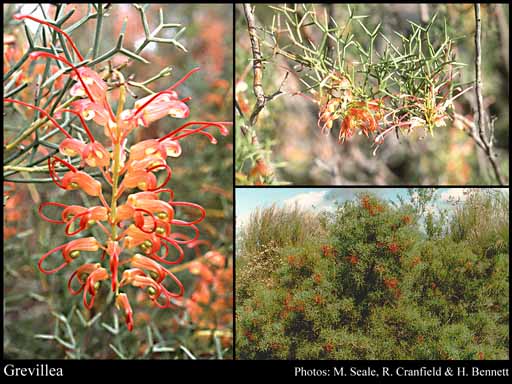- Reference
- Cult.Prot. pxvii, 120. (1809)
- Name Status
- Current







Scientific Description
Common name. Grevilleas. Family Proteaceae.
Habit and leaf form. Small trees, or shrubs; evergreen. Mesophytic, or xerophytic. Heterophyllous, or not heterophyllous. Leaves small to medium-sized; alternate; usually spiral; leathery, or fleshy; petiolate, or sessile; non-sheathing; aromatic, or without marked odour; edgewise to the stem, or with ‘normal’ orientation; simple, or compound; epulvinate; pinnate, or bipinnate, or multiply compound. Leaflets oblong, or linear; flat, or solid; terete. Leaf blades usually dorsiventral, or isobilateral, or centric; dissected (lobed to deeply divided), or entire; flat, or solid; terete, or semi-terete; when simple, elliptic, or oblong, or ovate, or obovate, or linear; when simple/dissected pinnatifid, or palmately lobed, or dichotomously dissected, or much-divided. Leaves without stipules. Leaf blade margins entire, or dentate. Leaves without a persistent basal meristem. Leaf anatomy. Hairs present, or absent. Stem anatomy. Secondary thickening developing from a conventional cambial ring.
Reproductive type, pollination. Fertile flowers hermaphrodite. Unisexual flowers absent. Plants hermaphrodite. Entomophilous, or ornithophilous, or pollinated by unusual means (by small marsupials).
Inflorescence and flower features. Flowers aggregated in ‘inflorescences’. Inflorescence few-flowered, or many-flowered. Flowers in pairs, subtended by a common bract; in racemes. The terminal inflorescence unit racemose (or two flowered). Inflorescences often terminal, or axillary; of loose racemes, solitary or often in panicles; without involucral bracts; pseudanthial, or not pseudanthial. The fruiting inflorescence conelike (? sometimes), or not conelike. Flowers pedicellate; bracteate; small to large (often very showy); regular, or very irregular; when irregular, zygomorphic. The floral asymmetry when present, involving the perianth and involving the androecium. Flowers mainly 4 merous; cyclic; tetracyclic, or tricyclic. Floral receptacle developing a gynophore, or with neither androphore nor gynophore. Free hypanthium present, or absent. Hypogynous disk present, or absent; extrastaminal; of separate members, or annular. Perianth of ‘tepals’; (3–)4 (G. donaldiana possessing 3 tepals, with a large adaxial tepal and two shorter abaxial ones); 1 -whorled; joined (tube curved or straight); green, or white, or cream, or yellow, or orange, or red, or pink. Androecium (3–)4. Androecial members adnate; all equal, or markedly unequal; free of one another; 1 -whorled. Stamens (3–)4; reduced in number relative to the adjacent perianth, or isomerous with the perianth; filantherous, or with sessile anthers (or subsessile). Anthers more or less basifixed; non-versatile; dehiscing via longitudinal slits; introrse; four locular; tetrasporangiate; appendaged (? via the elongated connective), or unappendaged. Gynoecium 1 carpelled. The pistil 1 celled. Gynoecium monomerous; of one carpel; superior. Carpel fully closed, or incompletely closed; stylate; apically stigmatic; 2 ovuled. Placentation marginal (? mostly), or apical. Ovary usually stipitate, or sessile, or subsessile. Ovules funicled, or sessile; non-arillate; orthotropous, or anatropous, or amphitropous, or hemianatropous.
Fruit and seed features. Fruit falling from the plant before the next growing season; non-fleshy (mostly thin-walled or leathery, G. glauca an exception with woody fruits). The fruiting carpel dehiscent; a follicle. Follicles compact; without septa. Gynoecia of adjoining flowers combining to form a multiple fruit, or not forming a multiple fruit. The multiple fruits coalescing, or not coalescing. Fruit 2 seeded. Seeds non-endospermic; usually winged, or wingless. Seed wings usually encircling body, or not encircling body (sometimes forming a partial border; membranous). Embryo well differentiated. Cotyledons 2(–8). Embryo straight.
Special features. Stamens inserted within a concavity near the end of a perianth segment. Leaf blades dorsiventral, or unifacial, or dipleural, or terete.
Geography, cytology, number of species. Native of Australia. Not endemic to Australia. Australian states and territories: Western Australia, South Australia, Northern Territory, Queensland, New South Wales, Victoria, Australian Capital Territory, and Tasmania. Northern Botanical Province, Eremaean Botanical Province, and South-West Botanical Province. Australia, Papua New Guinea, Indonesia and New Caledonia.
Etymology. After Charles Francis Greville (1749–1809), one of the founders of the Horticultural Society, now the Royal Horticultural Society; introduced and grew rare plants at Paddington, London.
Taxonomic Literature
- Hollister, Chris; Lander, Nicholas 2007. Western Australian Proteaceae : interactive identification & information retrieval : Banksia & Dryandra, Conospermum, Grevillea, Hakea, Isopogon & Petrophile. Western Australian Herbarium.. [Kensington, W.A.]..
- Olde, Peter M.; Marriott, Neil R. 2002. One new Banksia and two new Grevillea species (Proteaceae: Grevilleoideae) from Western Australia.
- Wheeler, Judy; Marchant, Neville; Lewington, Margaret; Graham, Lorraine 2002. Flora of the south west, Bunbury, Augusta, Denmark. Volume 2, dicotyledons. Australian Biological Resources Study.. Canberra..
- Australian Biological Resources Study 2000. Flora of Australia. Volume 17A, Proteaceae 2, Grevillea. CSIRO Publishing.. Canberra..
- Keighery, G. J. 1998. A new subspecies of Grevillea variifolia (Proteaceae).
- Olde, Peter; Marriott, Neil 1995. The Grevillea book. Volume 2, species A-L. Kangaroo Press.. Kenthurst, N.S.W..
- Olde, Peter; Marriott, Neil 1995. The Grevillea book. Volume 3, species M-Z. Kangaroo Press.. Kenthurst, N.S.W..
- Olde, Peter; Marriott, Neil 1994. The Grevillea book. Volume 1. Kangaroo Press.. Kenthurst, N.S.W..
- Olde, Peter M.; Marriott, Neil R. 1993. New species and taxonomic changes in Grevillea (Proteaceae: Grevilleoideae) from south west Western Australia.
- Wheeler, J. R.; Rye, B. L.; Koch, B. L.; Wilson, A. J. G.; Western Australian Herbarium 1992. Flora of the Kimberley region. Western Australian Herbarium.. Como, W.A..
- Blackall, William E.; Grieve, Brian J. 1988. How to know Western Australian wildflowers : a key to the flora of the extratropical regions of Western Australia. Part I : Dicotyledons (Casuarinaceae to Chenopodiaceae). University of W.A. Press.. [Perth]..